
A tetrapod is any four-limbed vertebrate animal of the superclass Tetrapoda. Tetrapods include all extant and extinct amphibians and amniotes, with the latter in turn evolving into two major clades, the sauropsids and synapsids. Some tetrapods such as snakes, legless lizards, and caecilians have evolved to become limbless via mutations of the Hox gene, although some do still have a pair of vestigial spurs that are remnants of the hindlimbs.

Sarcopterygii — sometimes considered synonymous with Crossopterygii — is a clade including both a group of bony fish commonly referred to as lobe-finned fish, and tetrapods. They are characterised by prominent muscular limb buds (lobes) within their fins, which are supported by articulated appendicular skeletons. This is in contrast to the other clade of bony fish, the Actinopterygii, which have only skin-covered bony spines supporting the fins.

Ichthyostega is an extinct genus of limbed tetrapodomorphs from the Late Devonian of what is now Greenland. It was among the earliest four-limbed vertebrates ever in the fossil record and was one of the first with weight-bearing adaptations for terrestrial locomotion. Ichthyostega possessed lungs and limbs that helped it navigate through shallow water in swamps. Although Ichthyostega is often labelled a 'tetrapod' because of its limbs and fingers, it evolved long before true crown group tetrapods and could more accurately be referred to as a stegocephalian or stem tetrapod. Likewise, while undoubtedly of amphibian build and habit, it is not a true member of the group in the narrow sense, as the first modern amphibians appeared in the Triassic Period. Until finds of other early stegocephalians and closely related fishes in the late 20th century, Ichthyostega stood alone as a transitional fossil between fish and tetrapods, combining fish and tetrapod features. Newer research has shown that it had an unusual anatomy, functioning more akin to a seal than a salamander, as previously assumed.
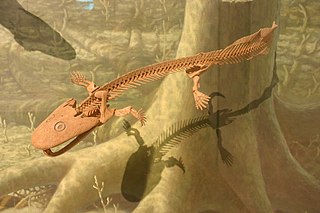
Acanthostega is an extinct genus of stem-tetrapod, among the first vertebrate animals to have recognizable limbs. It appeared in the late Devonian period about 365 million years ago, and was anatomically intermediate between lobe-finned fishes and those that were fully capable of coming onto land.

Panderichthys is a genus of extinct sarcopterygian from the late Devonian period, about 380 Mya. Panderichthys, which was recovered from Frasnian deposits in Latvia, is represented by two species. P. stolbovi is known only from some snout fragments and an incomplete lower jaw. P. rhombolepis is known from several more complete specimens. Although it probably belongs to a sister group of the earliest tetrapods, Panderichthys exhibits a range of features transitional between tristichopterid lobe-fin fishes and early tetrapods. It is named after the German-Baltic paleontologist Christian Heinrich Pander. Possible tetrapod tracks dating back to before the appearance of Panderichthys in the fossil record were reported in 2010, which suggests that Panderichthys is not a direct ancestor of tetrapods, but nonetheless shows the traits that evolved during the fish-tetrapod evolution

Tiktaalik is a monospecific genus of extinct sarcopterygian from the Late Devonian Period, about 375 Mya, having many features akin to those of tetrapods. Tiktaalik is estimated to have had a total length of 1.25–2.75 metres (4.1–9.0 ft) based on various specimens.
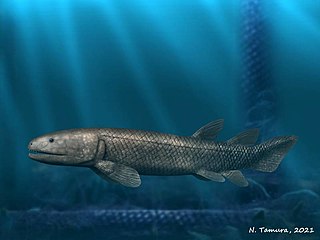
Tetrapodomorpha is a clade of vertebrates consisting of tetrapods and their closest sarcopterygian relatives that are more closely related to living tetrapods than to living lungfish. Advanced forms transitional between fish and the early labyrinthodonts, such as Tiktaalik, have been referred to as "fishapods" by their discoverers, being half-fish, half-tetrapods, in appearance and limb morphology. The Tetrapodomorpha contains the crown group tetrapods and several groups of early stem tetrapods, which includes several groups of related lobe-finned fishes, collectively known as the osteolepiforms. The Tetrapodomorpha minus the crown group Tetrapoda are the stem Tetrapoda, a paraphyletic unit encompassing the fish to tetrapod transition.
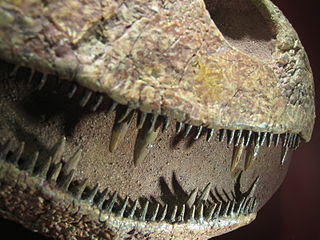
Tristichopterids (Tristichopteridae) were a diverse and successful group of fish-like tetrapodomorphs living throughout the Middle and Late Devonian. They first appeared in the Eifelian stage of the Middle Devonian. Within the group sizes ranged from a few tens of centimeters (Tristichopterus) to several meters.
Kenichthys is a genus of sarcopterygian fish from the Devonian period, and a member of the clade Tetrapodomorpha. The only known species of the genus is Kenichthys campbelli, the first remains of which were found in China in 1993. The genus is important to the study of the evolution of tetrapods due to the unique nature of its nostrils, which provide vital evidence regarding the evolutionary transition of fish-like nostrils to the tetrapod choanae.
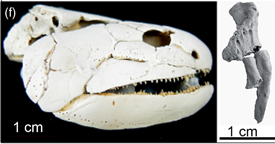
Gogonasus was a lobe-finned fish known from three-dimensionally preserved 380-million-year-old fossils found from the Gogo Formation in Western Australia. It lived in the Late Devonian period, on what was once a 1,400-kilometre-long coral reef off the Kimberley coast surrounding the northwest of Australia. Gogonasus was a small fish reaching 30 to 40 centimetres in length.

A walking fish, or ambulatory fish, is a fish that is able to travel over land for extended periods of time. Some other modes of non-standard fish locomotion include "walking" along the sea floor, for example, in handfish or frogfish.

Elpistostege is an extinct genus of finned tetrapodomorphs that lived during the Frasnian age of the Late Devonian epoch. Its only known species, E. watsoni, was first described in 1938 by the British palaeontologist Thomas Stanley Westoll, based on a single partial skull roof discovered at the Escuminac Formation in Quebec, Canada.

A digit is one of several most distal parts of a limb, such as fingers or toes, present in many vertebrates.
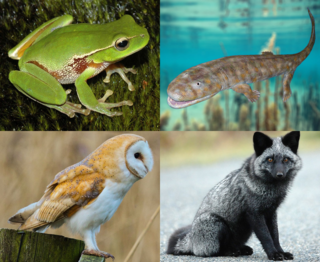
Stegocephali is a clade of vertebrate animals containing all fully limbed tetrapodomorphs. It is equivalent to a broad definition of the superclass Tetrapoda: under this broad definition, the term "tetrapod" applies to any animal descended from the first vertebrate with four limbs each with five digits in the extremity (pentadactyly), rather than fins of their sarcopterygian relatives.

Ichthyostegalia is an order of extinct amphibians, representing the earliest landliving vertebrates. The group is thus an evolutionary grade rather than a clade. While the group are recognized as having feet rather than fins, most, if not all, had internal gills in adulthood and lived primarily as shallow water fish and spent minimal time on land.

The Stem Tetrapoda are a cladistically defined group, consisting of all animals more closely related to extant four-legged vertebrates than to their closest extant relatives, but excluding the crown group Tetrapoda. They are thus paraphyletic, though acceptable in phylogenetic nomenclature as the group is defined by strict reference to phylogeny rather than to traits as in traditional systematics. Thus, some finned sarcopterygians are considered to be stem tetrapods.

The evolution of tetrapods began about 400 million years ago in the Devonian Period with the earliest tetrapods evolved from lobe-finned fishes. Tetrapods are categorized as animals in the biological superclass Tetrapoda, which includes all living and extinct amphibians, reptiles, birds, and mammals. While most species today are terrestrial, little evidence supports the idea that any of the earliest tetrapods could move about on land, as their limbs could not have held their midsections off the ground and the known trackways do not indicate they dragged their bellies around. Presumably, the tracks were made by animals walking along the bottoms of shallow bodies of water. The specific aquatic ancestors of the tetrapods, and the process by which land colonization occurred, remain unclear. They are areas of active research and debate among palaeontologists at present.
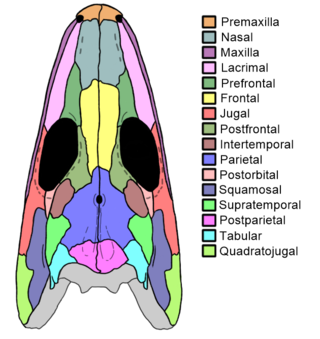
The Intertemporal bone is a paired cranial bone present in certain sarcopterygians and extinct amphibian-grade tetrapods. It lies in the rear part of the skull, behind the eyes.
The Zachelmie trackways are a series of Middle Devonian-age trace fossils in Poland, purportedly the oldest evidence of terrestrial vertebrates (tetrapods) in the fossil record. These trackways were discovered in the Wojciechowice Formation, an Eifelian-age carbonate unit exposed in the Zachełmie Quarry of the Świętokrzyskie Mountains (Holy Cross Mountains]. The discovery of these tracks has complicated the study of tetrapod evolution. Morphological studies suggest that four-limbed vertebrates are descended from a specialized type of tetrapodomorph fish, the epistostegalians. This hypothesis was supported further by the discovery and 2006 description of Tiktaalik, a well-preserved epistostegalian from the Frasnian of Nunavut. Crucial to this idea is the assumption that tetrapods originated in the Late Devonian, after elpistostegalians appear in the fossil record near the start of the Frasnian. The Zachelmie trackways, however, appear to demonstrate that tetrapods were present prior to the Late Devonian. The implications of this find has led to several different perspectives on the sequence of events involved in tetrapod evolution.
The evolution of fishes took place over a timeline which spans the Cambrian to the Cenozoic, including during that time in particular the Devonian, which has been dubbed the "age of fishes" for the many changes during that period.
























